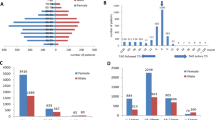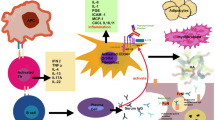Abstract
Aim
The prevalence of thyroid orbitopathy, compared with an estimate for the United Kingdom population, is examined in a large cohort of patients treated for periocular lymphoma.
Patients and methods
Clinical details were reviewed for patients presenting to the Orbital Clinic at Moorfields Eye Hospital with biopsy-proven periocular lymphoma. Recorded evidence of prior thyroid gland abnormality or thyroid eye disease was sought and treatment details recorded, together with that of the subsequent periocular lymphoma. The calculated prevalence of thyroid orbitopathy in our patients with periocular lymphoma was compared with an estimate based upon published figures for a United Kingdom population.
Results
Of 369 patients with periocular lymphoma, 20 (5%) had a history of thyroid disease and adequate notes were available in 10 cases: All had autoimmune thyrotoxicosis between 11 and 27 years (median 17.5) before diagnosis of periocular lymphoma and 6/10 had thyroid orbitopathy—none receiving orbital radiotherapy for treatment of their thyroid eye disease. Using a calculated estimate for the UK prevalence of thyroid orbitopathy, the probability of even these six cases of ophthalmopathy among 369 patients with periocular lymphoma is very low (P=0.007).
Conclusion
Compared with a population estimate, patients with periocular lymphoma had a significantly greater prevalence of preceding thyroid orbitopathy, with a median latency of 17 years. Thyroid orbitopathy possibly predisposes to later local lymphoma in a manner similar to the late emergence of lymphoma with other chronic inflammatory diseases—such as Sjögren's syndrome, Hashimoto's thyroiditis, coeliac disease, or Helicobactergastritis.
Similar content being viewed by others
Introduction
Chronic inflammation of extra-ocular muscles and periocular fat in thyroid orbitopathy (ophthalmopathy) is due to cell-mediated and humoral immunity, with frequent serum antibodies against thyroglobulin, thyroid microsomes, and thyroid stimulating hormone (TSH) receptors. The strong association of autoimmune thyroid orbitopathy and autoimmune thyrotoxicosis suggests a shared antigen for both conditions—the favoured one being TSH receptors on the preadipocyte sub-population of periocular fibroblasts.1, 2
Several autoimmune diseases predispose to lymphoma, with a typical latency of 10–20 years—such as Hashimoto's thyroiditis,3, 4, 5 Sjögren's syndrome,6, 7 and coeliac disease.8, 9 Inflammatory glandular destruction and MALT acquisition in Sjögren's syndrome renders such patients about 44 times more likely to develop late-onset marginal zone lymphoma (MZL) in affected tissues.7 Lymphocyte accrual during the chronic inflammation of Hashimoto's thyroiditis predisposes to later lymphoma (most commonly follicle centre cell variant4) and intestinal lymphomas arising with coeliac disease (typically 7 years after onset8) are predominantly of high-grade T-cell histology.9 The chronic inflammation of gastric MALT due to Helicobacter pylori infection, although not autoimmune, also predisposes to the emergence of gastric marginal zone lymphoma,10, 11 and eradication of the infection can lead to disease regression.12
We report a series of patients with autoimmune thyrotoxicosis and thyroid orbitopathy, who later developed periocular lymphoma.
Patients and methods
Database records for patients with biopsy-proven lymphoma of the orbit or lids (hereafter termed ‘periocular’ lymphoma), treated at the Orbital Clinic at Moorfields Eye Hospital, were reviewed for a history of thyroid gland disease or thyroid orbitopathy. For those patients with a database history of thyrotoxicosis or thyroid orbitopathy, the clinical case notes were reviewed with special regard to the nature and chronology of the various conditions. Ethical review was not required for a retrospective investigation.
Results
A total of 369 patients were recorded, between 1979 and 1999, as presenting with periocular lymphoma, and 20 (5.4%) had evidence of a thyroid abnormality. Adequate clinical case notes were available for only 10 patients with autoimmune thyroid disease.
Six of the 10 patients had thyroid orbitopathy (Figure 1), four bilateral, with a median age of 36.5 years at diagnosis (range 23–64 years): 3/6 had medical treatment for thyrotoxicosis and 2/6 had systemic steroids and orbital decompression for ophthalmopathy; none underwent orbital radiotherapy or radio-iodine therapy. The median latency between diagnosis of thyroid orbitopathy and development of periocular lymphoma in the six patients was 17.5 years (range 15–27 years). In 4/10 patients without prior ophthalmopathy, the diagnosis of lymphoma and thyrotoxicosis was simultaneous in two patients, but with a latency of 17 and 51 years in the two others (the lymphoma being of later onset in each case).
All lymphomas were solely periocular (unilateral Stage IE) at presentation, being marginal zone variant in 9/10 and diffuse large B-cell lymphoma in one patient; the tumour affected mainly the retrobulbar tissues in three cases, the lacrimal gland (two cases) or the conjunctiva (five patients). The periocular disease was treated with external beam radiotherapy (30–32 Gy, in 2 Gy fractions) and the patient with diffuse large B-cell lymphoma received 3 cycles of CHOP adjunctive chemotherapy. All patients were alive at more than 5 years after the diagnosis of lymphoma, with a 5-year disease-free survival of 89% (Table 1).
Discussion
Owing to problems in case-note retrieval after more than two decades (only 10/20 notes being adequate for analysis), it is probable that this investigation's estimate for the prevalence of thyroid orbitopathy or autoimmune thyrotoxicosis after periocular lymphoma is too low. On this basis, among our patients with lymphoma the prevalence estimates for thyroid ophthalmopathy would appear to be at least 6/369 (1.6%), and at least 10/369 (2.7%) for autoimmune thyroid gland disease.
Although the annual incidence of thyroid ophthalmopathy in Olmsted County, Minnesota, was estimated as 16/100 000 for women and 2.9/100 000 for men,13 such data cannot readily be used for prevalence calculations. A reported UK prevalence of thyrotoxicosis is 2.2%,14 of which nearly two-thirds is autoimmune—that is, 1.4% prevalence. There have been various and changing reported incidences for overt ophthalmopathy in patients with autoimmune thyroid disease,15 but a recent UK estimate is about 30%16—giving a UK population estimated prevalence of about 0.4% (30% of 1.4%); at this prevalence, there should have been no more than two cases of orbitopathy among our 369 lymphoma patients. The observed prevalence of at least 6/369 (1.63%) patients with thyroid ophthalmopathy in our series is, therefore, highly unlikely to have occurred by chance (P=0.007).
Primary periocular lymphomas are uncommon, about 85% are low-grade (such as marginal zone, diffuse lymphoplasmacytoid, or follicle cell lymphoma17), and most involve the deep orbit (44%) or lacrimal gland (26%).18 Nine of the 10 cases in this investigation were MZL, the variant commonly arising in Sjogren's syndrome, Hashimoto's thyroiditis, or H. pylori infection; the 90% proportion of MZL after autoimmune thyroid disease is, however, much greater than the 37% found in a large, unselected cohort.16 It is also of interest that 8/10 lymphomas arose anteriorly, this predilection for conjunctival and lacrimal gland (as with all periocular MZL18) possibly reflecting the normal presence of MALT in these two tissues.
As lymphoma may emerge from a background of chronic lymphocytic stimulation—often autoimmune—the unexpectedly high prevalence (at least 1.6%) of preceding thyroid orbitopathy in patients with periocular lymphoma (median latency 17.5 years; range 11–27) suggests a causal relationship between the two conditions. The statistical association is supported by examples of other lymphomas arising in other chronic inflammatory conditions—such as Sjogren's syndrome, Hashimoto's thyroiditis, coeliac disease, and gastric lymphoma.
References
Weetman AP . Graves' disease. N Engl J Med 2000; 343: 1236–1248.
Bahn RS, Dutton CM, Natt N, Joba W, Spitzweg C, Heufelder AE . Thyrotropin receptor expression in Graves' periocular adipose/connective tissues: potential auto-antigen in Graves' ophthalmopathy. J Clin Endocrinol Metab 1998; 83: 998–1002.
Hyjek E, Isaacson PG . Primary B cell lymphoma of the thyroid and its relationship to Hashimoto's thyroiditis. Hum Pathol 1988; 19: 1315–1326.
Aozasa K . Hashimoto's thyroiditis as a risk factor of thyroid lymphoma. Acta Pathol Jpn 1990; 40: 459–468.
Scholefield JH, Quayle AR, Harris SC, Talbot CH . Primary lymphoma of the thyroid, the association with Hashimoto's thyroiditis. Eur J Surg 1992; 18: 89–92.
Mariette X . Lymphomas in patients with Sjogren's syndrome: review of the literature and physiopathologic hypothesis. Leuk Lymphoma 1999; 33: 93–99.
Kassan SS, Thomas TL, Moutsopoulos HM, Hoover R, Kimberley RP, Budman DR et al. Increased risk of lymphoma in sicca syndrome. Ann Intern Med 1978; 89: 888–892.
Swinson CM, Coles EC, Slavin G, Booth CC . Coeliac disease and malignancy. Lancet 1983; 1: 111–115.
Murray A, Cuevas EC, Jones DB, Wright DH . Study of the immunohistochemistry and T-cell clonality of enteropathy associated T-cell lymphoma. Am J Pathol 1995; 146: 509–519.
Wotherspoon AC, Ortiz-Hidalgo C, Falzon MR, Isaacson PG . Helicobacter pylori-associated gastritis and primary B-cell gastric lymphoma. Lancet 1991; 338: 1175–1176.
Ech M, Schmauber B, Greiner A, Muller-Hermelink HK . Helicobacter Pylori in gastric mucosa-associated lymphoid tissue type lymphoma. Recent Results Cancer Res 2000; 156: 9–18.
Wotherspoon AC, Doglioni C, Diss TC, Pan L, Moschini A, deBoni M et al. Regression of primary low grade B-cell gastric lymphoma of mucosa-associated lymphoid tissue type after eradication of Helicobacter pylori. Lancet 1993; 342: 575–577.
Bartley GB, Fatourechi V, Kadrmas EF, Jacobsen SJ, Ilstrup DM, Garrity JA et al. The incidence of Graves' disease in Olmsted County, Minnesota. Am J Ophthalmol 1995; 120: 511–517.
Tunbridge WMG, Evered DC, Hall R, Appleton D, Brewis M, Clark F et al. The spectrum of thyroid disease in a community: the Wickham Survey. Clin Endocrinol 1977; 7: 481–493.
Cawood C, Moriarty P, O'Shea D . Recent developments in thyroid eye disease. BMJ 2004; 329: 385–390.
Kendall-Taylor P, Perros P . Clinical presentation of thyroid associated orbitopathy. Thyroid 1998; 8: 427–428.
Jenkins C, Rose GE, Bunce C, Wright JE, Cree IA, Plowman N et al. Histological features of ocular adnexal lymphoma (REAL classification) and their association with patient morbidity and survival. Br J Ophthalmol 2000; 84: 907–913.
Jenkins C, Rose GE, Bunce C, Cree I, Norton A, Plowman PN et al. Clinical features associated with survival of patients with lymphoma of the ocular adnexa. Eye 2003; 17: 809–820.
Author information
Authors and Affiliations
Rights and permissions
About this article
Cite this article
Nutting, C., Shah-Desai, S., Rose, G. et al. Thyroid orbitopathy possibly predisposes to late-onset of periocular lymphoma. Eye 20, 645–648 (2006). https://doi.org/10.1038/sj.eye.6702027
Published:
Issue Date:
DOI: https://doi.org/10.1038/sj.eye.6702027
Keywords
This article is cited by
-
The 2017 Doyne Lecture: the orbit as a window to systemic disease
Eye (2018)
-
Orbital and ocular adnexal Mucosa-Associated Lymphoid Tissue (MALT) lymphomas: a single-center 10-year experience
Medical Oncology (2013)
-
CT and MRI findings with histopathologic correlation of a unique bilateral orbital mantle cell lymphoma in Graves’ disease: a case report and brief review of literature
Journal of Neuro-Oncology (2010)




